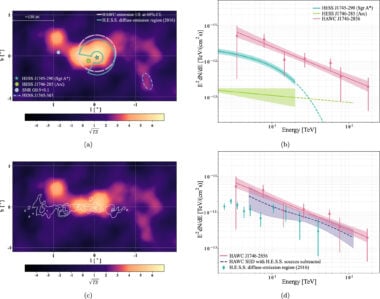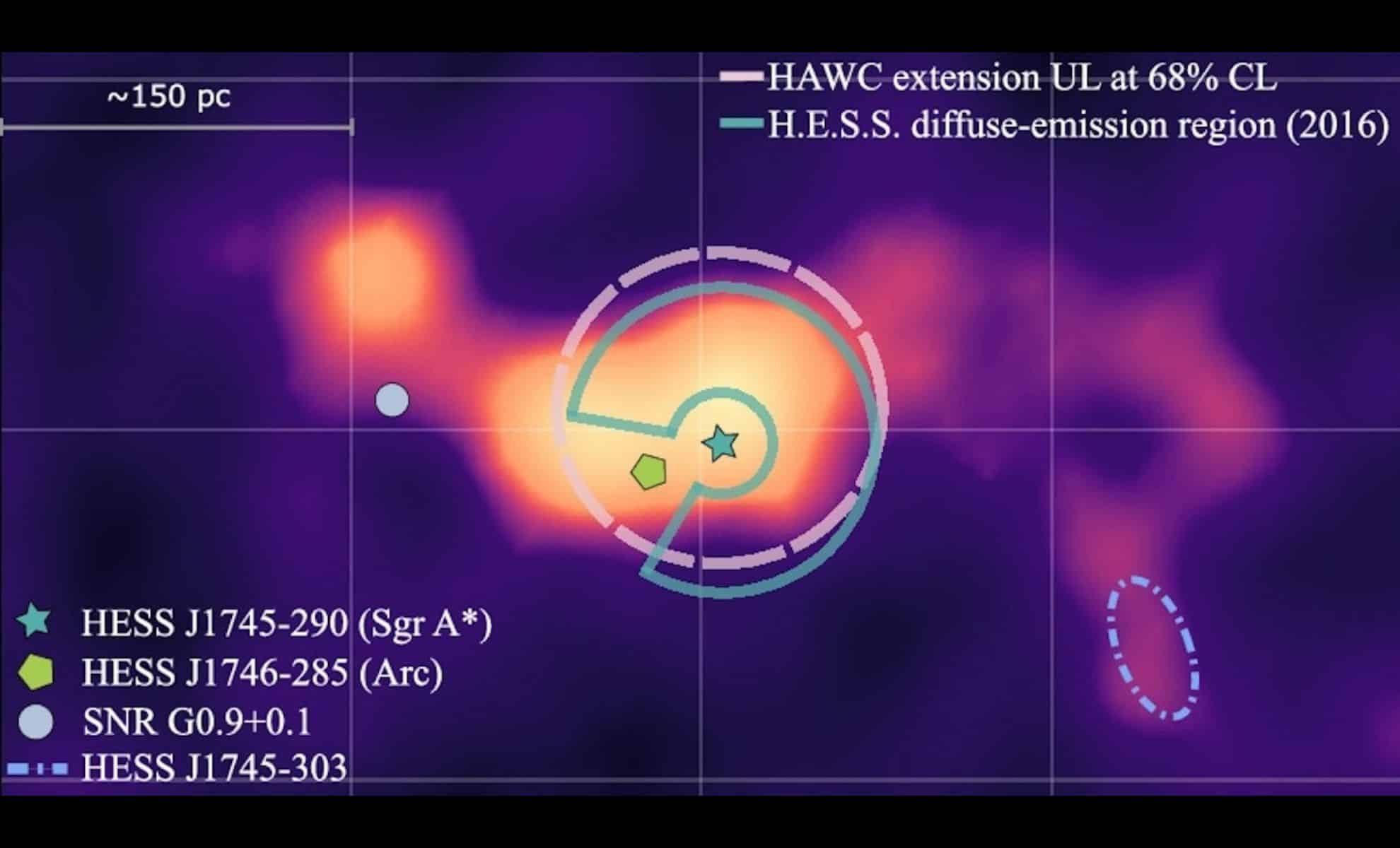Researchers have detected the most powerful gamma rays ever recorded at the center of the Milky Way, confirming the presence of a PeVatron, a cosmic accelerator that produces some of the most extreme physical processes in the universe. These gamma rays, detected by the HAWC observatory, offer unprecedented insights into the violent environment surrounding the galaxy’s core, home to supermassive black holes and energetic cosmic rays.
Record-Breaking Gamma Rays Erupt from the Heart of the Milky Way, Scientists Confirm

Scientists have made a groundbreaking discovery, detecting the most powerful gamma rays ever observed in the Milky Way, emanating from its tumultuous center.
These gamma rays, with energy levels exceeding 100 teraelectron volts (TeV), were detected using the High-Altitude Water Cherenkov (HAWC) observatory in Mexico. The discovery has provided new insights into the extreme processes occurring near the Milky Way’s Galactic Center Ridge, a region believed to host some of the most energetic phenomena in the universe.
PeVatrons: Uncovering Extreme Cosmic Accelerators
The detection of these ultrahigh-energy gamma rays represents a significant step forward in understanding the mysterious forces at work in the galaxy's core. At the heart of the discovery is the confirmation of a PeVatron, a powerful cosmic particle accelerator capable of pushing protons and other particles to extreme energies, reaching up to 1 quadrillion electron volts (PeV). Pat Harding, a physicist at Los Alamos National Laboratory, emphasized the importance of this find, stating, “These results are a glimpse at the center of the Milky Way to an order of magnitude higher energies than ever seen before.” The gamma rays detected by HAWC provide the first direct evidence of a PeVatron in the Galactic Center Ridge, a region known for harboring highly energetic processes.
PeVatrons are rare and elusive cosmic phenomena, responsible for accelerating cosmic rays to incredibly high velocities, approaching the speed of light. The interaction between these cosmic rays and the dense gas and magnetic fields in the galactic center produces gamma rays of extreme energy. These gamma rays are among the most powerful particles ever observed from within the Milky Way. As Harding pointed out, “The research for the first time confirms a PeVatron source of ultrahigh-energy gamma rays at a location in the Milky Way known as the Galactic Center Ridge.”

A Violent Environment at the Milky Way's Heart
The Galactic Center of the Milky Way, home to the supermassive black hole Sagittarius A*, is one of the most energetic and dynamic regions in the galaxy. Although Sagittarius A* itself is relatively inactive, the surrounding area is a hub of intense activity, with neutron stars, supernova remnants, and dense clouds of gas contributing to the violent cosmic environment. This region is largely obscured in visible light due to the dense clouds of gas and dust that surround it, making gamma-ray observations critical for revealing the extreme physical processes taking place.
The detection of these ultrahigh-energy gamma rays, made possible by the HAWC observatory, represents a significant breakthrough in understanding this chaotic region. The findings, which tracked 98 gamma-ray events over seven years, were published in The Astrophysical Journal Letters. This research provides the first confirmation of a PeVatron in the Galactic Center Ridge, giving scientists a clearer picture of the processes that produce these extreme particles.
Future Research and the Mysteries of PeVatrons
While the detection of ultrahigh-energy gamma rays from the Milky Way’s center is a major breakthrough, many questions remain unanswered. PeVatrons, while theorized, are still not fully understood, and researchers are eager to learn more about how these cosmic accelerators operate. The fact that such high-energy processes are taking place within our own galaxy is surprising, as similar phenomena are usually associated with more distant or larger galaxies.
The next steps in this research will involve further observations and analyses to pinpoint the exact source of the gamma rays. To achieve this, the scientific community is looking forward to the completion of the Southern Wide-field Gamma-ray Observatory (SWGO), currently under construction in Chile's Atacama Desert. This facility will allow researchers to capture a wider range of gamma-ray signals, providing a more detailed view of the Galactic Center and its extreme processes. Researchers hope that SWGO will help them answer key questions about the nature of PeVatrons and the role they play in the broader context of galactic evolution.
Sohyoun Yu-Cárcamo, a physicist leading the analysis, emphasized the significance of this discovery, noting that “the cosmic ray density is higher than the galactic average in the galactic center,” suggesting that a fresh source of accelerated protons exists in this region. The continued study of these phenomena will deepen our understanding of how galaxies like the Milky Way evolve and how they produce some of the most powerful forces in the universe.
Implications for Space Exploration and Particle Physics
The detection of such high-energy gamma rays has far-reaching implications, not just for astronomy, but for particle physics and our understanding of the universe’s most fundamental forces. Gamma rays are the most energetic form of electromagnetic radiation, and studying their origins helps researchers understand the processes that drive the acceleration of particles in space. These findings could also impact future space missions, as cosmic rays and high-energy particles pose risks to both astronauts and spacecraft, particularly for missions beyond the protective environment of Earth's magnetosphere.
The confirmation of a PeVatron within the Milky Way is a critical step toward solving the mystery of how particles reach such extreme energies and how these powerful forces shape the evolution of galaxies.



